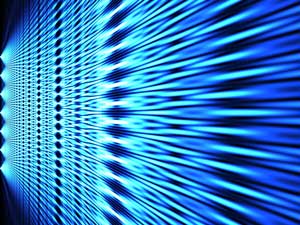 Investigadores en la Universidad de Illinois han creado una computadora quantica que resuelve problemas cuando esta apagada. Ver la notica en Nature.
Investigadores en la Universidad de Illinois han creado una computadora quantica que resuelve problemas cuando esta apagada. Ver la notica en Nature.
"This is bizarre even by the weird standards of quantum mechanics, which is notorious for counterintuitive effects. Hosten and colleagues call it 'counterfactual' quantum computation: a way of probing the outcome of an event by looking at situations in which it didn't actually happen."
Imagen: Del Articulo, Possibilities and Limitations of Quantum Computing (descripción de la imagen: Quantum computers strengthen the computational paths leading to correct solutions. This can be compared to constructive interference of waves. Photo courtesy of John K.N. Murphy, www.hotquanta.com)
23.2.06
Strangely beautiful quantum weirdness
Publicadas por
Andrés Hax
a la/s
2/23/2006
![]()
Suscribirse a:
Comentarios de la entrada (Atom)

1 comentario:
Close window
Published online: 22 February 2006; | doi:10.1038/news060220-10
The computer that works when it's idle
Quantum computers get the answer without being turned on.
Philip Ball
Just because it isn't running doesn't mean it won't give you an answer.
© Punchstock
A striking new way to compute the answer of a mathematical problem sounds like a slacker's dream: you turn on your computer, program it to solve the problem, but then don't have to run the program. Provided you are using a quantum computer, you'll have a fair chance of getting the answer anyway.
It sounds absurd. But Onur Hosten of the University of Illinois at Urbana-Champaign and colleagues have shown that it works. The have created a kind of quantum computer using light beams, and find that it can find a particular item in a database without actually looking for it.
This is bizarre even by the weird standards of quantum mechanics, which is notorious for counterintuitive effects. Hosten and colleagues call it 'counterfactual' quantum computation: a way of probing the outcome of an event by looking at situations in which it didn't actually happen.
All together now
A quantum computer is very different from a traditional desktop computer. It uses the laws of quantum mechanics to perform many calculations at once where a conventional computer could do them only one at a time. This drastically cuts the time a quantum computer takes to find the answer.
This is made possible by the fact that quantum objects, such as individual atoms or photons of light, can be placed in 'superposition' states, mixtures of states that are mutually exclusive in everyday objects. A quantum switch, for example, could be simultaneously on and off.
That's the key to quantum computation, because it means that a quantum computer can be placed in a superposition of states where it is running and not running. This leaves an imprint of the 'running' state on the history of the 'not running' state, such that one can look at the latter and determine something about the former.
"Some people like to think of this as two different universes", explains computer scientist Richard Josza of Bristol University in England. In one universe the computer runs, while in a parallel universe it doesn't.
One might say then that the computer does actually run, but in a 'parallel universe'. "So you wouldn't be charged for the cost of running it," says Josza.
Not so simple
But there's a catch. The outcomes of quantum processes can never be predicted precisely, but only in terms of probabilities. So quantum computation doesn't invariably give the right answer.
When the idea was first proposed by Josza eight years ago, some researchers thought that the success rate would actually be so low that one could do just as well by guessing.
Hosten and colleagues have found a way to avoid this limitation, they report in Nature1. It uses another strange quantum phenomenon, known as the quantum Zeno effect. This amounts to changing the probability of a particular outcome simply by looking for it. It is a realization of the adage that a watched kettle never boils: for a 'quantum kettle', you really can prevent 'boiling' forever just by watching it.
The researchers created a simple 'quantum computer' from laser beams, mirrors and light detectors, which encodes information in the quantum states of photons. In effect, they put a single photon in a superposition of states in which it both is and isn't fed into an optical 'black box' that processes its quantum state according to an algorithm. They then look at the photon to see whether the answer to the calculation is encoded in it.
The team took advantage of the Zeno effect in probing the 'non-running' states of their computer, in which the photon didn't pass through the black box, therebye increasing the probability of finding the answer.
Strangely beautiful
"It's a very beautiful experiment that probes the strangeness of quantum theory," says Josza.
Hosten and colleagues say that this is more than just an exercise in quantum weirdness; they think it might help in making useful quantum computers. So far, such devices constructed from light beams or trapped atoms are mere toys, which have far too little computing power to solve really hard problems.
One of the obstacles to scaling up such model computers is that it is very hard to prevent quantum information from leaking away into the surroundings. This leakage is largely due to the way that quantum bits interact with their environment as the computation proceeds. But if the computation isn't actually run at all, this leakage might be much smaller, making quantum computation less error-prone.
Post a comment to this story by visiting our newsblog.
Top
References
Hosten O., et al. Nature, 439 . 949 - 952 (2006). | Article |
Top
Story from news@nature.com:
http://news.nature.com//news/2006/060220/060220-10.html
© 2004 Nature Publishing Group | Privacy policy
Publicar un comentario